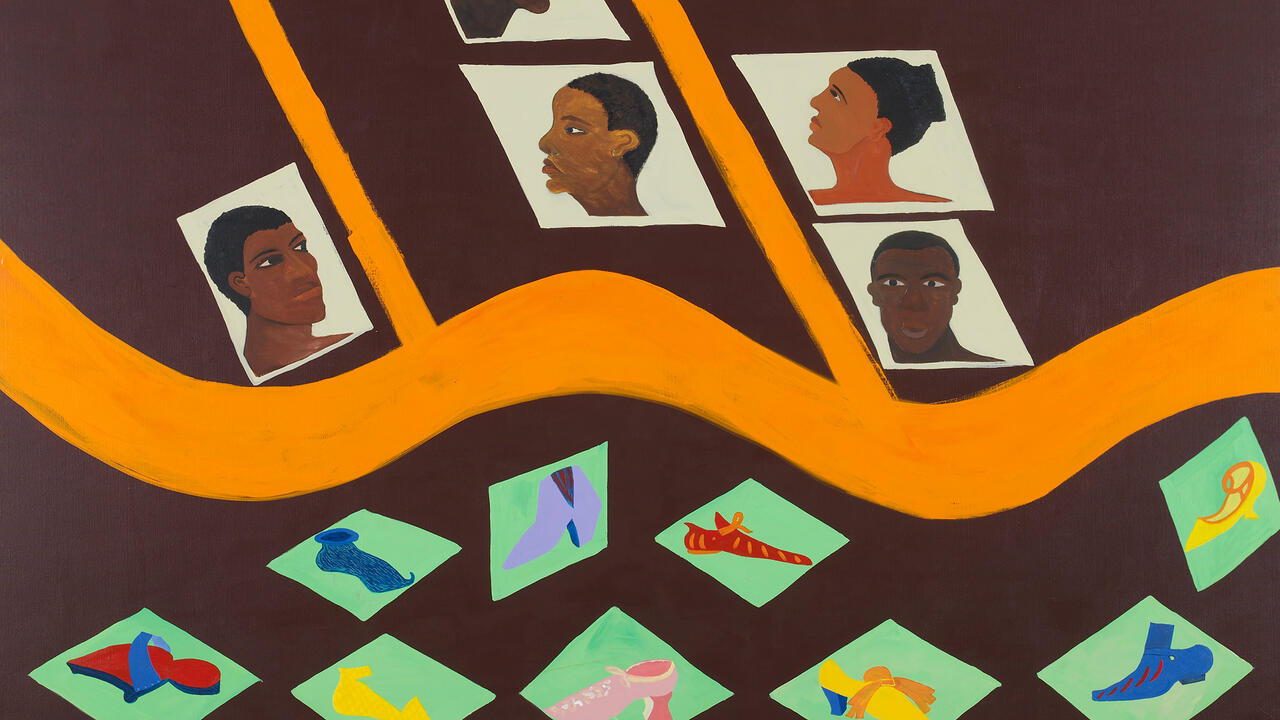Julie Verhoeven
Institute of Contemporary Art, London, UK
Institute of Contemporary Art, London, UK

Overflowing with breasts and bums, Julie Verhoeven’s cheekily titled exhibition, ‘Whiskers Between My Legs’, transformed the ICA’s tiny Fox Reading Room into a carnival of feminine excess interrupted by odd moments of toilet humour. Layers of absurd costumes, garish fabric sculptures and mangled theatre props burst from the gallery walls, creating a rich tapestry that curved up towards the ceiling like a quilted cave. In one corner, a silky, pink, vagina-shaped cushion sprouts rubber gloves and paint brushes from its orifice. From the roof, the sleeves of a dildo-shaped costume hang down to caress a paint-splattered rug. Tiny details emerge from the chaos like witty one-liners: a bejewelled tampon hangs from a messy tangle of cords; a tissue box is disguised as a papier-mâché brick; a soft sculpture of traffic lights boasts nipples; toilet paper rolls hang from every available hook.
Nestled within the clutter are nine small television monitors, each displaying an identical six-minute looped video. The monitors are obscured, either covered with plastic or half-hidden behind decorated toilet seats. This technique emphasizes installation over storyline, but the success of Verhoeven’s approach is diminished by the size of the monitors: it is difficult to catch comic details and I don’t always get the joke.
The video itself is a bizarre mash-up of three types of imagery: wacky fashion shoots, deadpan feminist performance art and juvenile cartoons. The first consists of Verhoeven’s deliberately tacky costumes depicted onscreen, worn by a string of thin white models (including a cameo by London-based art collector, Valeria Napoleone). Some of these costumes mock idealized femininity, such as the fluoro dress with attached prosthetic breasts that droop down to the wearer’s waist. Others, like the loo-roll necklace, are pure juvenile fun. However, I was left dumbstruck by a brief and perplexing moment of blackface: footage of a blonde woman, with black face-paint and foam on her chin, staring defiantly at the camera. The image smacks of historical ignorance and, as one offended fan wrote on the ICA’s YouTube channel: ‘The use of this American aesthetic used to mock and dehumanize black people for entertainment since the advent of chattel slavery is not an aesthetic that you, a white woman, should be indulging in.’ A more generous reading, however, would be to interpret this problematic imagery as a dark parody of the fashion industry, where the allure of edginess too often triumphs over cultural sensitivity. (Interestingly, the ICA is currently showing a major solo exhibition by the Dutch photographer Viviane Sassen whose work has caused controversy by blurring the registers of high fashion and documentary-style photography of African and Surinamese subjects.)
More entertaining is the series of absurd performances by a naked woman that seem to parody earnest body-based practices from the 1970s. Filmed in close-up, these shots fragment the young woman’s body as she performs witty puns such as pulling tissues from a ‘box’ between her legs. In other clips, she mocks erotic self-expression, wearing bright red oven glove to seductively brush icing sugar over her body. After she drops her knickers in a bold flourish, the camera catches her awkwardly retrieving them. Like many of her contemporaries – including Shana Moulton, Hannah Raisin and Mika Rottenberg – Verhoeven uses irony to enact a strategic distancing from earlier forms of feminist practice while also reiterating their corporeal concerns.
With incredible comic timing, Verhoeven’s multi-layered parody of fashion and feminism is intersected with puerile cartoons, such as a dripping penis wearing high heels. One of these animations depicts a woman transformed into a headless sewing machine: kneeling on all fours and strapped into fetish boots, her nipples weave thread into a long phallic sausage. The clip acts as a sarcastic nod to Allen Jones’s misogynist sculpture Table (1969), concurrently on show at the Royal Academy of Arts, where it provoked the same feminist fury it elicited when first exhibited more than 40 years ago. With my blood still boiling from an earlier visit to Jones’s retrospective, I welcomed Verhoeven’s underhand punch: if the Royal Academy wants to institutionally celebrate blatant sexism, then let Verhoeven sew Jones’s castration anxiety into a cathedral of tampons and toilets. Ironically, Jones’s show made all too clear the continued necessity of Verhoeven’s fiercely funny feminism.






















